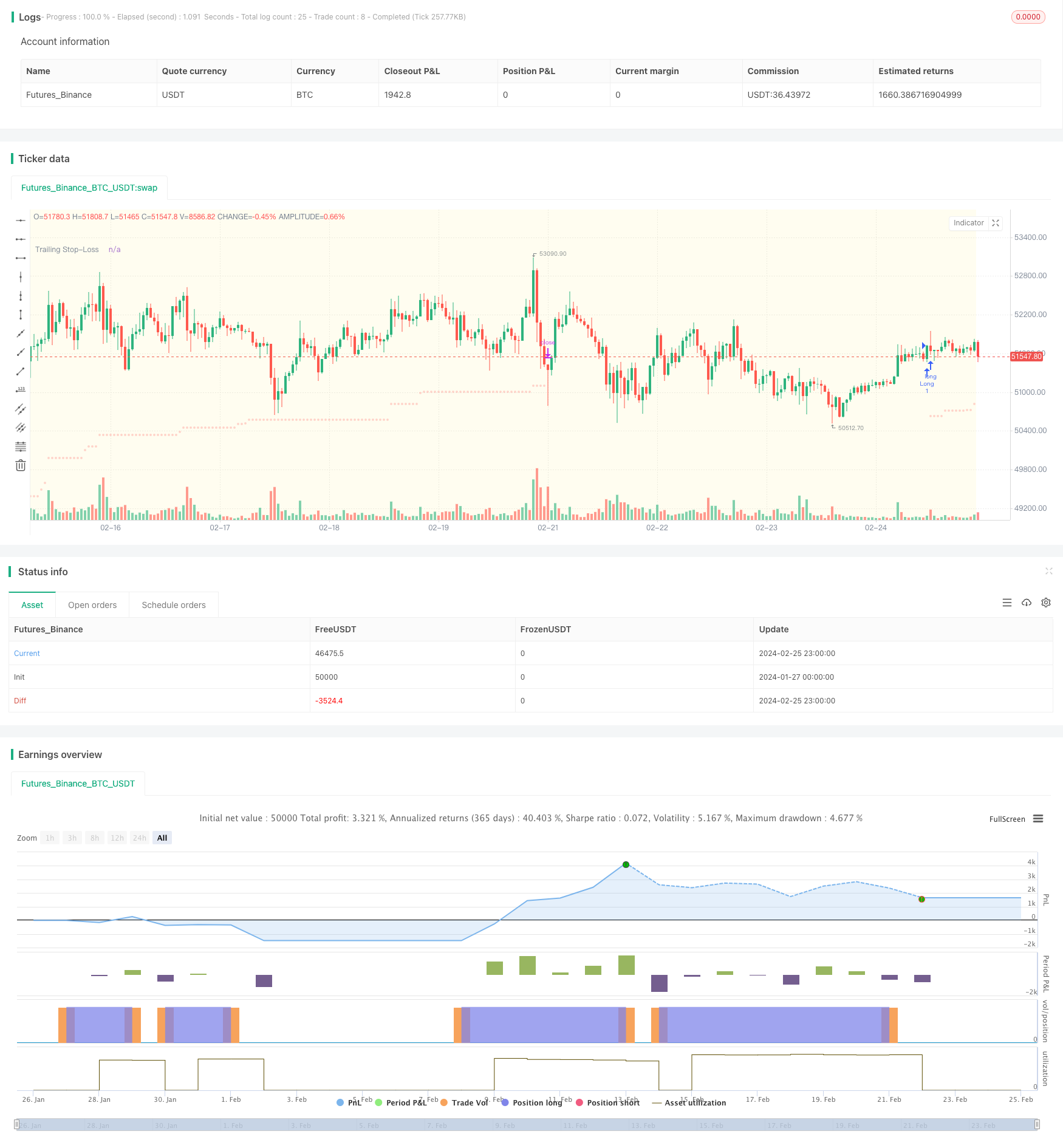
概述
本策略基于动态移动指标(DMI)设计了一个只做多头的长线策略,同时结合平均真实波幅(ATR)进行尾随止损,以控制亏损风险。为了进一步优化,该策略还融入了交易时间和标准普尔500指数的季节性过滤条件,具有一定的优势。
策略原理
该策略只在指定的交易日(周一至周五)和交易时间(默认为当地时间9:30-20:30)开仓。
当ADX大于27时,表示目前处于价格趋势状态。此时如果+DI线上穿-DI线,产生做多信号。
开仓后,以ATR的5.5倍设置止损位,并且止损线会随价格上涨而上移,确保获利。
可选地应用标准普尔500指数的季节性规则,只在历史上表现较好的时段开仓。
优势分析
结合趋势指标和止损机制,能够有效跟踪趋势,并控制 einzelnen头寸的损失。
利用交易时间和季节性过滤条件,可以避开市场的异常波动期,降低误报率。
DMI和ATR均为成熟的技术指标,参数调整灵活,适合量化优化。
风险分析
DMI和ATR参数设置不当可能导致信号过多或过少。需要调参数进行测试。
止损幅度设大了可能造成不必要的止损。设小了可能无法有效控制损失。
交易时间和季节性规则可能过滤掉部分利润机会。需要评估滤波效果。
优化方向
可以考虑结合其他指标,如MACD、布林带等,设计进场和出场规则。
可以测试不同的ATR倍数止损方式,也可以考虑动态调整止损幅度。
可以测试调整交易时间段,或优化季节性交易的开始结束时间。
可以尝试应用机器学习方法自动优化参数。
总结
本策略整合趋势分析与风险控制技术,在一定程度上克服了趋势跟踪策略的剧烈抖动问题。同时加入交易时间和季节性过滤,可以减少错误信号。通过参数调优和功能扩展,本策略可以获得更好的稳定收益。
策略源码
/*backtest
start: 2024-01-27 00:00:00
end: 2024-02-26 00:00:00
period: 1h
basePeriod: 15m
exchanges: [{"eid":"Futures_Binance","currency":"BTC_USDT"}]
*/
//@version=5
strategy(title="DMI Strategy with ADX and ATR-based Trailing SL (Long Only) and Seasonality", shorttitle="MBV-SP500-CLIMBER", overlay=true)
// Eingabeparameter für Long-Positionen
len = input.int(14, minval=1, title="DI Length")
lensig = input.int(14, title="ADX Smoothing", minval=1, maxval=50)
adxLongThreshold = input.float(27.0, title="ADX Threshold for Long", minval=0)
atrLength = input.int(14, title="ATR Length")
atrLongMultiplier = input.float(5.5, title="ATR Multiplier for Trailing SL (Long)")
startTimeHH = input.int(09, title="startTime hh")
startTimeMM = input.int(30, title="startTime mm")
endTimeHH = input.int(20, title="endTime hh")
endTimeMM = input.int(30, title="endTime mm")
// Zeitzone des Nutzers als Eingabeparameter
timezoneOffset = input.int(1, title="Timezone Offset (Hours from UTC)", minval=-12, maxval=14)
// Zusätzliche Einstellung für SP500-Saisonalität
enableSeasonality = input.bool(false, title="Enable SP500 Seasonality")
seasonColor = color.new(color.blue, 90)
activeTimeColor = color.new(color.yellow, 90) // Farbe für aktive Handelszeiten
// Handelstage und -zeiten
tradeMonday = input.bool(true, title="Trade on Monday")
tradeTuesday = input.bool(true, title="Trade on Tuesday")
tradeWednesday = input.bool(true, title="Trade on Wednesday")
tradeThursday = input.bool(true, title="Trade on Thursday")
tradeFriday = input.bool(true, title="Trade on Friday")
// Konvertierung der Uhrzeit in Unix-Zeitstempel
getUnixTime(hour, minute) =>
adjustedHour = hour - timezoneOffset
sessionDate = timestamp(year, month, dayofmonth, 0, 0)
sessionDate + adjustedHour * 60 * 60000 + minute * 60000
// Start- und Endzeit als Unix-Zeitstempel
// + 1 Stunde wegen UTC
startTime = getUnixTime(startTimeHH, startTimeMM)
endTime = getUnixTime(endTimeHH, endTimeMM)
// Überprüfen, ob der aktuelle Zeitpunkt innerhalb der Handelszeit liegt
isTradingTime() => true
// Saisonale Zeiträume definieren
isSeason(time) =>
m = month(time)
d = dayofmonth(time)
(m == 1 and d >= 1) or (m == 2 and d <= 15) or (m == 3 and d >= 23) or (m == 4 and d <= 17) or (m == 5 and d >= 12) or (m == 6 and d >= 27 and d <= 8) or (m == 7 and d <= 29) or (m == 10 and d >= 15) or (m == 11 and d >= 1) or (m == 12 and d <= 2) or (m == 12 and d >= 20 and d <= 27)
// Hintergrundfarbe für saisonale Bereiche und aktive Handelszeiten
bgcolor(enableSeasonality and isSeason(time) ? seasonColor : na)
bgcolor(isTradingTime() ? color.new(activeTimeColor, 90) : na)
// Berechnung von +DM, -DM, ATR
up = ta.change(high)
down = -ta.change(low)
plusDM = na(up) ? na : (up > down and up > 0 ? up : 0)
minusDM = na(down) ? na : (down > up and down > 0 ? down : 0)
trur = ta.rma(ta.tr, len)
atr = ta.atr(atrLength)
// Berechnung von +DI, -DI und ADX
plus = fixnan(100 * ta.rma(plusDM, len) / trur)
minus = fixnan(100 * ta.rma(minusDM, len) / trur)
sum = plus + minus
adx = 100 * ta.rma(math.abs(plus - minus) / (sum == 0 ? 1 : sum), lensig)
// Logik für LONG Signale unter Berücksichtigung der Saisonalität und Zeitfilter
longSignal = ta.crossover(adx, adxLongThreshold) and plus > minus and isTradingTime()
longSignal := longSignal and (not enableSeasonality or (enableSeasonality and isSeason(time)))
// Variable für Trailing Stop-Loss
var float longTrailingSL = na
// Variablen für die Eröffnungszeit und den Eröffnungspreis der Position
var int openBarIndex = na
var float openPrice = na
// Handelslogik für Long-Positionen
// ohne strategy.position_size == 0 gilt die Kondition für ALLE Signale und nicht nur für das erste
if (longSignal and strategy.position_size == 0)
strategy.entry("Long", strategy.long)
openBarIndex := bar_index
openPrice := close
longTrailingSL := close - atr * atrLongMultiplier
//if (longSignal)
//longTrailingSL := close - atr * atrLongMultiplier
// Aktualisierung des Trailing Stop-Loss
if strategy.position_size > 0
longTrailingSL := math.max(longTrailingSL, close - atr * atrLongMultiplier)
// Ausstieg aus Long-Positionen
strategy.exit("Close Long", "Long", stop=longTrailingSL)
// Anzeige des ATR-basierten Trailing Stops für Long-Positionen
//plot(strategy.position_size > 0 ? longTrailingSL : na, color=color.red, title="ATR Trailing Stop Long")
// Anzeige des ATR-basierten Trailing Stops für Long-Positionen
plot(strategy.position_size > 0 ? longTrailingSL : na, color=color.new(color.red, 75), style=plot.style_circles, linewidth=1, title="Trailing Stop-Loss")
// Wenn eine Position geschlossen wird, zeichnen Sie die Linie
// if strategy.position_size[1] > 0 and strategy.position_size == 0
// lineColor = longTrailingSL > openPrice ? color.new(color.green, 50) : color.new(color.red, 50) // Hellgrün für Gewinne, Hellrot für Verluste
// line.new(openBarIndex, openPrice, bar_index, longTrailingSL, width=3, color=lineColor)